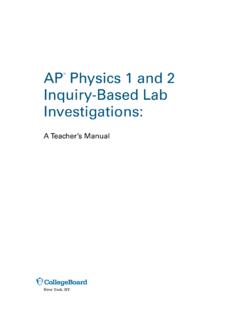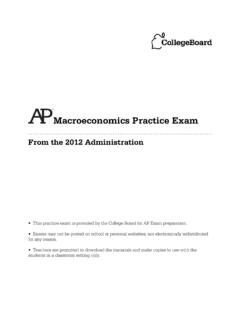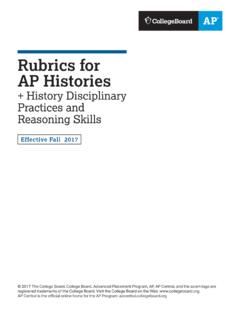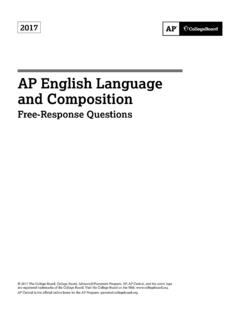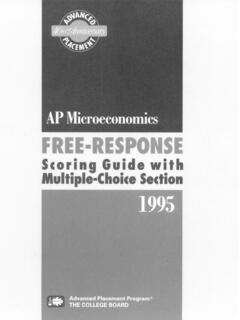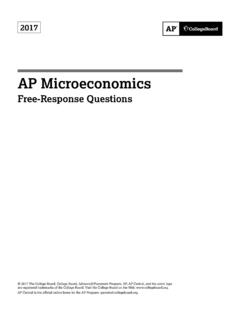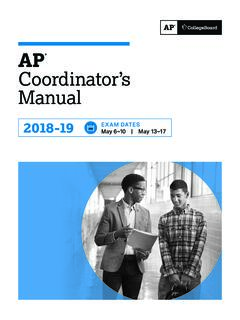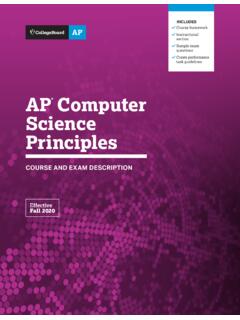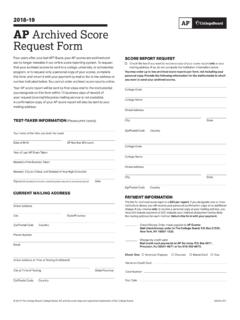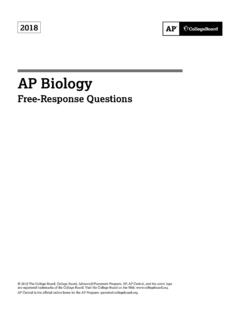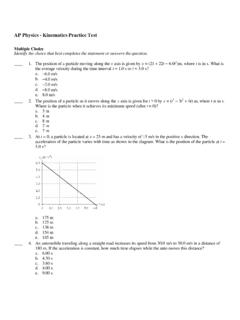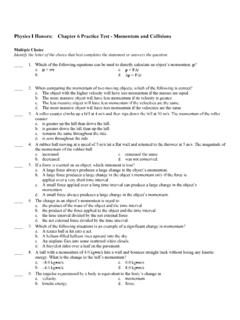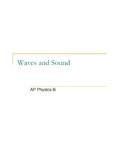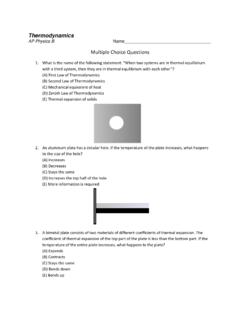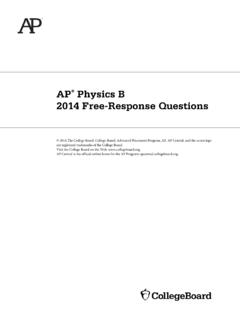Transcription of AP Physics 1 and 2 Inquiry-Based Lab Manual
1 Teacher s ManualAP Physics 1 and 2 Inquiry-Based Lab InvestigationsAP Physics 1 and 2 Inquiry-Based Lab Investigations:A Teacher s ManualNew York, NYiiAbout the College BoardThe College Board is a mission-driven not-for-profit organization that connects students to college success and opportunity. Founded in 1900, the College Board was created to expand access to higher education. Today, the membership association is made up of over 6,000 of the world s leading educational institutions and is dedicated to promoting excellence and equity in education.
2 Each year, the College Board helps more than seven million students prepare for a successful transition to college through programs and services in college readiness and college success including the SAT and the Advanced Placement Program . The organization also serves the education community through research and advocacy on behalf of students, educators, and further information, visit Equity and Access PolicyThe College Board strongly encourages educators to make equitable access a guiding principle for their AP programs by giving all willing and academically prepared students the opportunity to participate in AP.
3 We encourage the elimination of barriers that restrict access to AP for students from ethnic, racial, and socioeconomic groups that have been traditionally underserved. Schools should make every effort to ensure their AP classes reflect the diversity of their student population. The College Board also believes that all students should have access to academically challenging course work before they enroll in AP classes, which can prepare them for AP success. It is only through a commitment to equitable preparation and access that true equity and excellence can be achieved.
4 2015 The College Board. College Board, Advanced Placement, Advanced Placement Program, AP, AP Central, and the acorn logo are registered trademarks of the College Board. All other products and services may be trademarks of their respective owners. Visit the College Board on the Web: v Acknowledgments FOR THE TEACHER 1 Chapter 1: About This Manual 5 Chapter 2: Overview of the Investigations 15 Chapter 3: A Lab at a Glance 21 Chapter 4: Creating an Inquiry-Based Learning Environment 27 Chapter 5: The Role of the Science Practices 29 Chapter 6: Overview of Quantitative Analysis 37 Chapter 7: Written, Verbal, and Visual Communication 39 Chapter 8.
5 Making AP Physics 1 and 2 Inclusive for All Learners 43 References and Resources AP Physics 1 INVESTIGATIONS 45 AP Physics 1 Investigation 1: 1D and 2D Kinematics 61 AP Physics 1 Investigation 2: Newton s Second Law 77 AP Physics 1 Investigation 3: Circular Motion 89 AP Physics 1 Investigation 4: Conservation of Energy 107 AP Physics 1 Investigation 5: Impulse and Momentum 123 AP Physics 1 Investigation 6: Harmonic Motion 141 AP Physics 1 Investigation 7: Rotational Motion 159 AP Physics 1 Investigation 8: Mechanical Waves 179 AP Physics 1 Investigation 9: Resistor Circuits AP Physics 2 INVESTIGATIONS 195 AP Physics 2 Investigation 1: Boyle s Law 211 AP Physics 2 Investigation 2: Fluid Dynamics 227 AP Physics 2 Investigation 3: RC Circuits 243 AP Physics 2 Investigation 4: Magnetism 261 AP Physics 2 Investigation 5: Electromagnetic Induction 273 AP Physics 2 Investigation 6: Geometric Optics 287 AP Physics 2 Investigation 7.
6 The Particle Model of Lightiv Contents APPENDIXES 313 Appendix A: Science Practices for AP Physics 1 and 2 321 Appendix B: Rubrics for Science Practices in AP Physics 1 and 2 Investigations 333 Appendix C: AP Physics 1 and 2 Constants and EquationsvAcknowledgmentsThe College Board would like to acknowledge the following individuals and committees for their commitment and dedication toward the completion of this Manual :Lab authors and major contributorsPeggy Ann Bertrand, University of Tennessee, Knoxville, TNJohn Eggebrecht, Brooklyn Technical High School, Brooklyn, NYArthur Eisenkraft, University of Massachusetts Boston, Boston, MAAndy Elby, University of Maryland, College Park, MDEugenia Etkina, Rutgers University, Piscataway, NJDolores Gende, Pine Crest School, Ft.
7 Lauderdale, FL Rebecca Howell, Lambert High School, Suwanee, GADavid Jones, Florida International University, Miami, FLStephen Kanim, New Mexico State University, Las Cruces, NMMartha Lietz, Niles West High School, Skokie, ILPaul Lulai, St. Anthony Village Senior High, Minneapolis, MNRobert Morse, St. Albans School (Retired), Washington, DCPatrick Polley, Beloit College, Beloit, WIMarc Reif, Fayetteville High School, Fayetteville, ARDavid Rosengrant, Kennesaw State University, Kennesaw, GAPeter Sheldon, Randolph College, Lynchburg, VA Gay Stewart, West Virginia University, Morgantown, WVJoseph Stieve, The Madeira School, McLean, VABeth Thacker, Texas Tech University, Lubbock, TXJim VanderWeide, Hudsonville High School, Hudsonville, MIConnie Wells, Pembroke Hill School, Kansas City.
8 MOReturn to Table of Contents 2015 The College BoardviAcknowledgmentsAP Science lab vision teamIn 2010, the College Board convened a group of subject matter and laboratory investigation experts to provide a model of excellence for what the investigative labs should be in AP Science courses. These individuals worked diligently to create a vision for exemplary AP science labs that would serve to assist teachers in facilitating Inquiry-Based and student-directed investigative work. This vision also serves as the input for professional development and resource materials that will support lab investigations for the redesigned science courses.
9 Arthur Eisenkraft, University of Massachusetts Boston, Boston, MAEugenia Etkina, Rutgers University, Piscataway, NJNivedita Ganguly, University of Tennessee, Knoxville, TNDolores Gende, Pine Crest School, Ft. Lauderdale, FLPeggy O Neill Skinner, The Bush School, Seattle, WASusan Singer, Carleton College, Northfield, MNAngelica Stacy, University of California, Berkeley, CAPeter Strom, Rutgers University, Piscataway, NJGordon Uno, The University of Oklahoma, Norman, OKDave Yaron, Carnegie Mellon University, Pittsburgh.
10 PAOTHER CONTRIBUTORS AP Physics Consultants AP Physics Curriculum Development and Assessment Committee AP Physics Development Committee AP Physics Focus Group ParticipantsAP Physics Lab Manual Reviewers AP Physics Lab Pilot Teachers AP Physics Readers College Board Science Academic Advisory CommitteeReturn to Table of Contents 2015 The College Board1 FOR THE TEACHERC hapter 1: About This Manual The AP Physics 1 and Physics 2 Algebra- based courses are designed to promote student learning of essential Physics content and foster development of deep conceptual understanding through an Inquiry-Based model of instruction.
